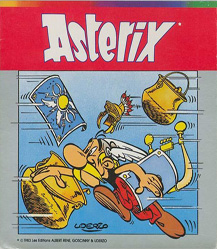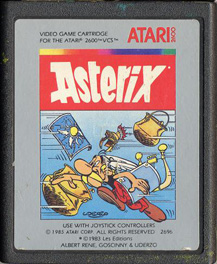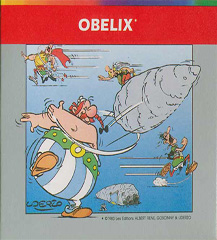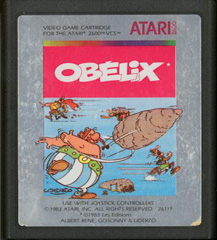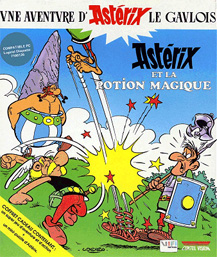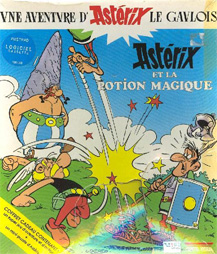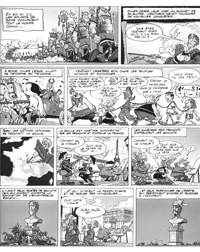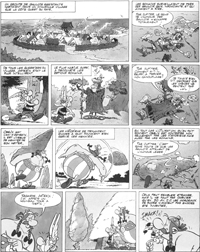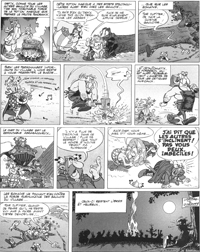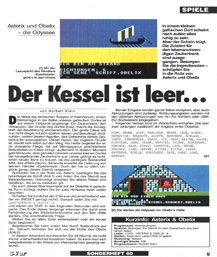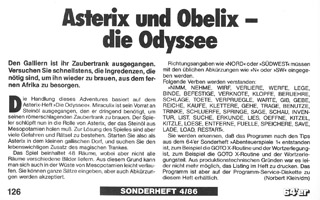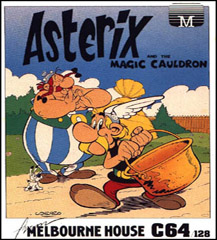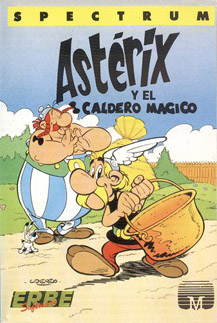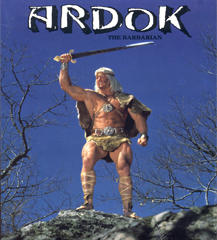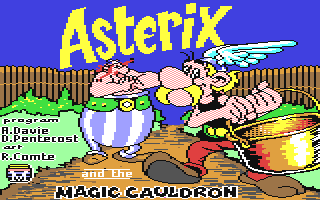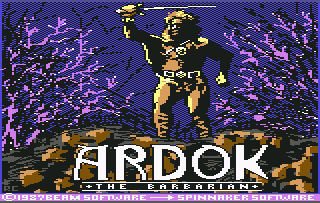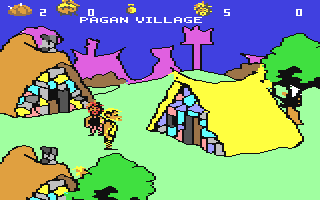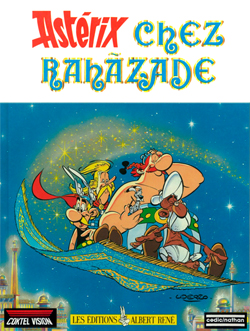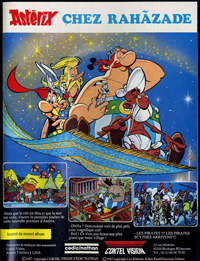
|
Page 1: |
Page 2: |
Page 3: |
Page 4: |
Page 5: |
|
Page 6: |
Page 7: |
Page 8: |
The very first video game to feature our favorite mustachioed hero was released on the Atari 2600, during the period in which Atari was losing its footing in Europe at a rapid speed. Astérix is an arcade style action game where the goal is to steer Astérix (depicted with a crude sprite slightly resembling his head) between 8 panels to pick up various treasures like magic cauldrons and avoid the deadly lyres of Assurancetourix. The game, like most of its counterparts at the time, loops infinitely making the goal of the game simply to acquire the highest score without dying. The lyres speed up as you gain more points, making it a challenging battle of reflexes and luck to get the high score. The game was designed by Steve Woita who would later go on to do programming for Sega.
The first Astérix game is not really a true Astérix game, however. Seasoned Atari gamers will probably already have gazed on the screenshots and feel they look awfully familiar. That's because this game was released earlier under an entirely different title, that being Taz, based on the Looney Tunes character. In that game Taz must avoid bundles of dynamite while picking up hamburgers. Other than the sprites, there are no differences between the two games. Both Astérix and Taz could be seen as variations of Turmoil, another Atari game with quite similar gameplay released one year prior. It's actually decent in its own right and provides some of the classic instant gaming fun that the Atari 2600 is famous for.
The game saw a full release in Europe. However, a small scattering of NTSC cartridges were produced and released in North America, though it is uncertain if it was ever sold in the US or just in Canada. Because of the extremely limited run, Astérix is considered one of the rarest NTSC games on the Atari 2600 and will fetch several hundred US dollars for the cartridge alone. The PAL version is more common and can be found with relative ease.
Quick Info:
|
Developer: |
|
|
Publisher: |
|
|
Designer: |
|
|
Genre: |
|
|
Themes: |
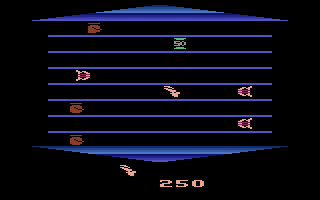
Astérix (Atari 2600)
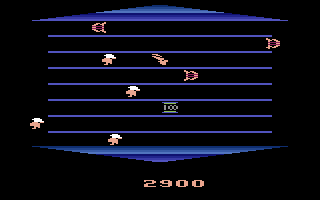
Astérix (Atari 2600)
Screenshots Comparisons
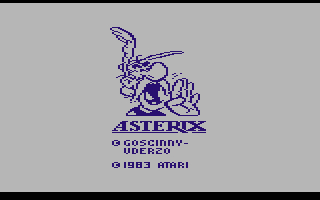
Astérix
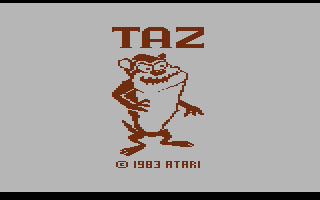
Taz

Astérix
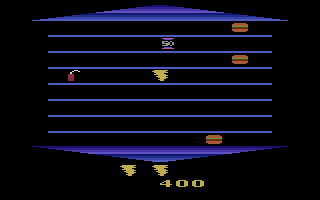
Taz
Strangely enough the Atari would see another Astérix game before its death. Obélix is a strategic arcade action game where Astérix and Obélix must work together through timing and precision to take out the Roman soldiers invading the village.
Each time Astérix runs into a soldier, the soldier turns white and will freeze. Obélix must then drop a menhir (a stone) on the stunned Roman by pressing the action button, and then you'll score points. The faster the Roman soldier is moving when Astérix stuns him, the more points you'll receive. If a stunned Roman is not knocked off by Obélix's menhir, he turns red with anger and can attack Astérix if they touch which causes you to lose points. Astérix can only overcome angry Romans if he catches a drop of magic potion which Panoramix drops from above. During this time, Astérix will flash and you can knock down the Romans by running through them. Unfortunately, the potion wears off quickly and as soon as it does, Astérix is vulnerable to red Romans again. You control Astérix left and right along the field and you can go up and down by lining up with the red bridges which appear randomly on the map. There are two types of enemies: Small solders and fat centurions, with the centurions giving more points per knockdown.
Unlike the first game, this one is not a conversion or rehash of an older title. While the premise sounds original and fun, the execution leaves a lot to be desired. Even when held to the standard of other Atari games which were all quite simple, this game gets really old quite fast and feels slow. Waiting for Obélix to line up with the frozen enemies becomes unbearably tedious and you'll soon line your finger up with the power button and shut the game off. Even though the game is named after the portly shaped sidekick, you don't actually control him beyond making him drop menhirs. The graphics are a definite step up though, and it sports some nice animations, especially for Panoramix. The sound effects are vintage Atari and there's a little jingle to start the game which sounds appropriate, so in terms of presentation it is superior to Astérix. Only released in PAL regions, it is quite rare today because of the limited release due to the video game market collapse.
Quick Info:
|
Developer: |
|
|
Publisher: |
|
|
Designer: |
|
|
Genre: |
|
|
Themes: |
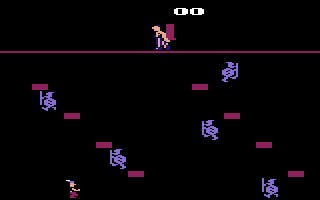
Obélix (Atari 2600)
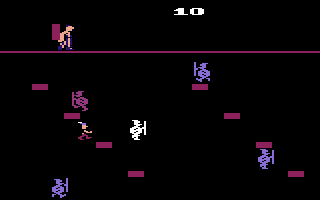
Obélix (Atari 2600)
The first true Astérix adventure came in 1986 on an ancient French home computer called the Thomson MO5, and eventually the Amstrad CPC. The MO5's reach outside of France was quite limited and with the Commodore 64 and Spectrum running wild across Europe, it never really tried to establish itself anywhere else except its home nation. The machine came with Microsoft BASIC built in, so the closest comparison to the MO5 would be the MSX1, with the games looking very similar between them. Despite being virtually unknown, the MO5 actually has a few notable titles to offer. This game, however, is certainly not one of them.
Astérix et la Potion Magique ("Astérix and the Magic Potion") is partially based on the central plot point of Astérix The Gaul. In the comic/movie, Astérix and Panoramix are captured by the Romans and commanded to reveal the recipe for the magic potion that makes the Gauls superhuman. They make a fake list of ingredients and send Romans to gather the rare items. When they return with every item on the list, Panoramix cooks up a potion and the Romans quickly consume all of it. It is then that the Romans realize this potion is not the magic potion that gives you strength, but rather a hair growth potion that makes the hair of their heads and beards grow a thousand times faster than normal.
In this game you control Astérix, primarily in search of the items. It starts out in the Gallic forest with no real clue or direction, so it's up to you to figure out this small but open play field. You can also employ the help of Obélix and Assurancetourix if you carry the specific items that allow you to summon them. Items are really the heart of this game, as you are looking for various things needed to make the hair elixir and items to help you overcome the obstacles you find along the trip. Astérix will have to face Roman legions and wild boars, with every confrontation draining his magic potion meter. Furthermore, there is a time limit that only increases from defeating Romans. Once all items are collected you head to the Roman camp and find Panoramix to end the game.
It is extremely difficult to manage everything that goes on in this game. First off Astérix can only carry one item at a time, which leads to a lot of backtracking. Now while enemies will reappear when backtracking, the magic potion refills won't, which means you have to start avoiding fights, but this drains the timer. When you pick up a new item the one you are currently holding will be dropped in its place which can completely break the game, because sometimes it means instant death to travel to a screen without the needed item. One example of this is needing the shield to pass the arrows. Obélix becomes playable only when you carry his dog Idéfix, and each time you use him you drain the Boar meter. Yes, another meter just for Obélix. His purpose in the game is minimal, however, as all he can do is punch down walls. Assurancetourix needs the harp to be selectable and his role in the game is even smaller. He is only needed once for removing the evil druid guarding the cave - after that you never need him again.
The most vile, foul and frustrating part is the controls. It cannot be stressed enough how bad they are. It can only be compared to making a blind grasshopper jump through an earring. Astérix jumps like he is on the moon and cannot change direction once launched. Most of the jumps take place in puzzlingly narrow spaces and each time you hit any object big or small, the jump is cancelled out and Astérix will start to descend straight down. None of this is helped by the game running at painfully low speeds, either. The main adventure could easily be completed in less than 10 minutes if one knows where the items are and what order to get them. But because of absolutely awful jumping it rather takes well over two days to get remotely close to the end, as there is no save function or continue. If you die, you start over. If you are playing this on an emulator, then raise the speed up to 300%, because that's the only way you can possibly bear playing this game.
The differences between the Amstrad and MO5 versions are not numerous. The CPC has more colors but less detail while the MO5 version's sprites, though transparent and single colored, are larger and have more detail through the transparency. There is no music on any version of this game, only a few sound effects for the fighting and dying which aren't much to write home about. The controls are even worse in the CPC version due to Astérix just drifting into the air as soon as you start jumping. The game registers each press, which, due to the slow speed, are queued up and delayed. You'll find yourself flying around the screen like a pinball because you try to steer yourself in the right direction with multiple presses, which all are performed one after another in the game with sometimes five second delays. Worse yet is that every foreign object you touch, including other Gauls, kills you instantly on the CPC version.
At the time of its release Astérix et la Potion Magique wasn't a good game to begin with, and with age it has only gotten worse. There's very little enjoyment to be found here even for hardcore Astérix fans. The only true good thing is the manual which featured an exclusive comic short called En 50 avant J-C (In 50 BC.) This comic would remain exclusive to the packaging of this game until 2003, when it was finally released in the short story compilation Astérix et la rentrée gauloise (Astérix and the Class Act).
Quick Info:
|
Developer: |
|
|
Publisher: |
|
|
Genre: |
|
|
Themes: |
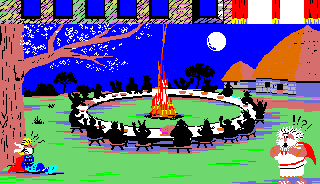
Astérix et la Potion Magique (Thomson MO5)
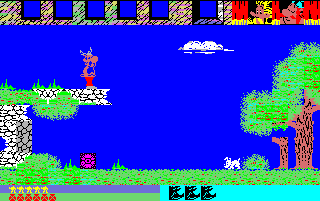
Astérix et la Potion Magique (Thomson MO5)
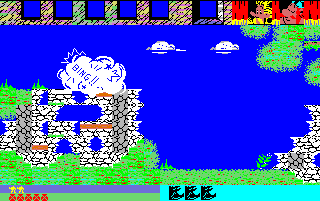
Astérix et la Potion Magique (Thomson MO5)
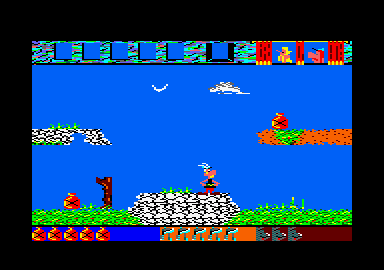
Astérix et la Potion Magique (Amstrad CPC)
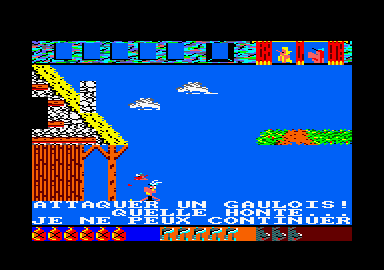
Astérix et la Potion Magique (Amstrad CPC)
En 50 avant J-C
Astérix und Obélix: Die Odyssee (Astérix and the Black Gold) was released as a free game that came along with the April edition of German C64 magazine 64'er in 1986. The game is a text adventure that follows the adventures from the book of the same title.
In Astérix und Obélix: Die Odyssee, Astérix must venture to the Middle East to fetch a batch of rock oil. Rock oil is one of the important ingredients to the magic potion and upon learning that he has run out of it, Panoramix has a stroke. Along with Astérix, Obélix and Idéfix, the druid Zérozérosix joins the group, but unbeknown to Astérix, he is a Roman-Gaulish spy. This adventure takes them all over the sea and Judea as they venture on to Jerusalem to find the rock oil. Upon arrival, they learn that the Romans knew of their plans and have seized all rock oil in the city, therefore they must cross the desert to Babylon in order to find it. After finally retrieving what they sought after for so long, they head back to Gaul but Zérozérosix returns and manages to pour the oil out at sea. Astérix returns home with his head in shame only to find the village fighting the Romans. He seeks out Panoramix to find out what happened and the druid informs him that he realized he could substitute the oil with beetroot juice and that there never was any crisis. Realizing the whole journey was for nothing, Astérix has a stroke himself to end the adventure.
This game follows that story in an extremely simplified manner. The game is controlled like any other text adventure where the player has to plot in the actions of the hero and hope it triggers the right event or goes in the right direction. The graphics and scenery are near non-existent, with often two plain colors of yellow and blue being the only thing shown on screen along with the narration. There is no music and even the narration offers very little to give any feel or guidance as to what exactly you are supposed to do or where you are in the world. Astérix himself never appears on screen but Obélix does at the very beginning, though he resembles a pig more than a human being.
For a game simply supplied as an extra in a game magazine, there's not much room for complaints. Even in its extreme simplicity, it does follow the general story and while the gameplay choice isn't ideal, it wasn't uncommon for comic book adaptations to take this route, with Scott Adams adventure games like The Incredible Hulk having the same style on the C64. You are better served by just reading the actual book instead of slowly figuring your way through it in German, so there's little reason to dig this out of the dust.
Quick Info:
|
Publisher: |
|
|
Designer: |
|
|
Genre: |
|
|
Themes: |
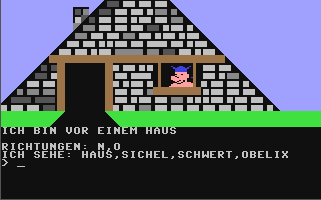
Title Screen
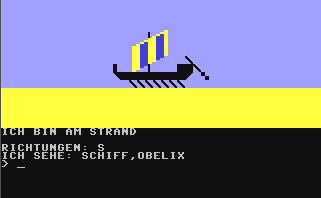
Astérix und Obélix: Die Odyssee
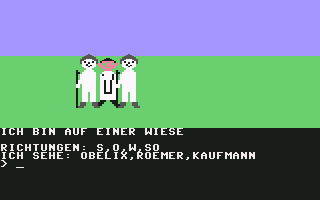
Astérix und Obélix: Die Odyssee
Astérix and the Magic Cauldron / Ardok the Barbarian - Amstrad CPC, Commodore 64, ZX Spectrum (1987)
It was only a matter of time before Astérix would appear on the most common and beloved home computer in Europe, and in fall of 1986 he finally arrived in his first official Commodore 64 outing with the open world adventure game: Astérix and The Magic Cauldron. It seemed to be in good hands as the developer, Beam Software, were certainly no strangers to making good games. The team had earlier had great success with The Way of the Exploding Fist and The Hobbit, and Astérix seemed to have "action platformer" written all over it when reading the comics or watching the movies. However, Beam thought differently and decided to take an approach similar to what Coktel Vision did on the Thomsom MO5.
The basic outline of the game is that you play as Astérix, who is in search of the seven pieces of the magic cauldron, which exploded during one of Panoramix' experiments. The explosion sent the pieces flying all over the countryside and even beyond the borders, and so it's up to you to make the dangerous trek with Obélix by your side. The world which you can explore is divided in 51 different screens, which are accessed from all directions. Both Astérix and Obélix are struck by hunger, which can only be satisfied by beating wild boars. Battles with Romans and boars are initiated by walking into them, which opens a small window that zooms in on the sprites and let you duke it out one on one. During fight mode you will see stamina meters for you and your opponent. If your meter goes to zero, you lose a life. If you simply stand still, the Romans will capture you and throw you in a jail cell. Also when you find items, the window will zoom in and allow you to walk over and pick it up. You begin with five lives and five boars.
When you start the game, you'll find yourself in a rather nice looking Gaul village. Astérix and Obélix look rather well done in their sprite forms - Astérix looks a bit tall maybe, but apart from that, so far so good. Random NPCs will walk by and the game does a rather good job at making the village feel alive. At first glance, it actually looks to be a good, faithful game worthy of the Astérix name. That is, until you step out of the screen for the first time. The game draws the map up as you step out of the screen, and this is not a quick process. Depending on the amount of scenery it has to draw, this is a process that can take over 15 seconds and you will be going back and forth through areas on a regular basis. Basically, the game's length is mostly due to the fact that you will be waiting for the screen to draw over and over and over again. Seeing that this game is all about exploration and searching, it's quite a crippling flaw.
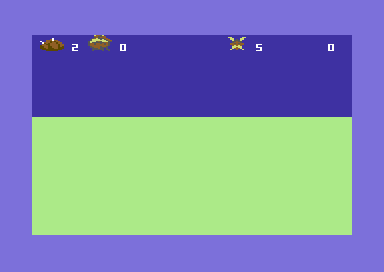
The game is frustrating and convoluted in various other aspects as well. Your boar meter drains at an annoying pace, and searching for boars in addition to the pieces of the cauldron makes your quest twice as long. There's really no good reason to fight Romans as they'll usually kick your ass, so escape is usually a better route to go down. Funnily enough, in order to escape you must slap the Roman at least once first as if Astérix is a little kid who rings the doorbell and runs away hiding in the bushes. The cauldron pieces are not easy to find, either. Today we always have walkthroughs and guides to look up online, but back then all you could do was get a pen and some paper, and draw your own map. When playing this game as kids, most people never knew where to go after the first few pieces were found because neither the game nor its manual give any hints. At one point you have to willingly surrender and mess around in jail in order to find one of the pieces. Confusing and complicated puzzles like this really don't feel very welcome when each screen takes half a minute to draw. To make matters worse the game features one of the most sinister item placements in video game history. The seventh piece is hidden behind a piece of scenery, so when walking around you cannot see it. This would cause lots of gamers to believe the game was bugged and could not be finished. This placement of the last piece was so damaging that two different crack groups actually released their own hacked version where they placed the last piece in the middle of the screen in order to make it possible to locate it. It's not like any of this is worth it. Once finished, the game flashes a message saying "BY TOUATIS YOU HAVE DONE IT" outside the gates of Rome. The game then restarts from the beginning seconds later.
The music is quite a piece of work. Composed by Neil Brennan of Way of the Exploding Fist and Bazooka Bill fame, it is hard to describe in words the hilarity of this soundtrack. While not horrible, the main theme is only what I can describe as a sea shanty with death metal drums. There are a few tunes in this game in addition to the swashbuckling headbanger, though most the other songs are only a few seconds long before looping over. All things considered the soundtrack might be the best part of this whole game. Even though the recipe for an Astérix game would obviously be a side scrolling beat-em-up, this game tries to do too much with very little. The size of the game is just too big for technology which can't render a lot more than a few things at a time and the result is that you have to sit to watch the world unfold for longer than you actually play. God might have created the world in 6 days but that doesn't mean I would bother watching the C64 take just as long.
The game was ported over to ZX Spectrum and the Amstrad CPC. There are minor differences to these versions, with the ZX Spectrum having less colors but more detail. There's only five pieces to be found on the Spectrum, but the drawing time is even longer than the C64 version. The Amstrad CPC version has better overall graphics and color schemes but movement is much slower than both the C64 and the Spectrum. Both CPC and Spectrum lack the music that is featured on the C64. Due to Astérix not having as much commercial value in the US, the game was changed into Ardok The Barbarian for its US release. It is essentially the same game but with barbarians looking for seven pieces of a shield.
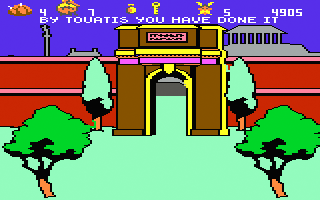
Quick Info:
|
Developer: |
|
|
Publisher: |
|
|
Genre: |
|
|
Themes: |
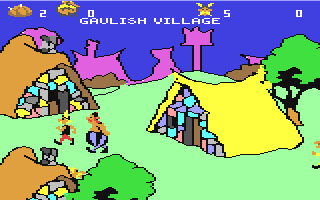
Astérix and the Magic Cauldron (C64)
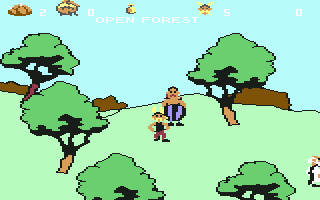
Astérix and the Magic Cauldron (C64)
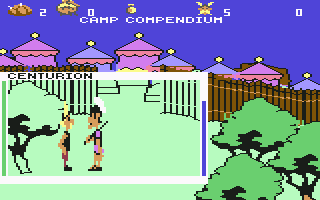
Astérix and the Magic Cauldron (C64)
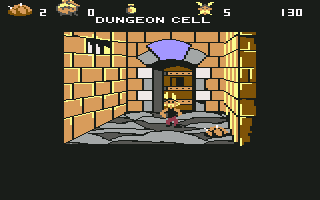
Astérix and the Magic Cauldron (C64)
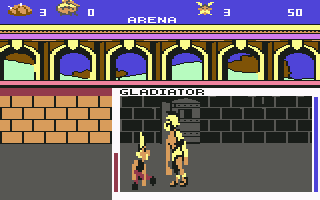
Astérix and the Magic Cauldron (C64)
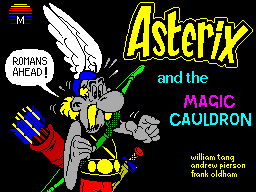
Astérix and the Magic Cauldron (ZX Spectrum)
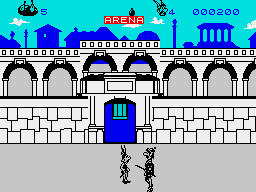
Astérix and the Magic Cauldron (ZX Spectrum)
Screenshot Comparisons
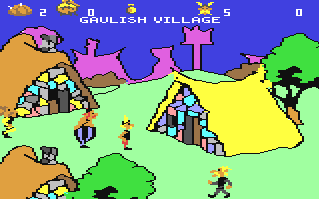
Commodore 64
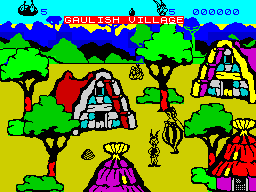
ZX Spectrum
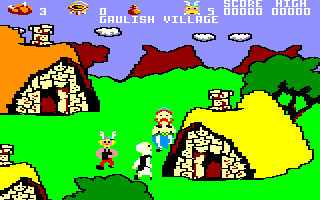
Amstrad CPC
Astérix & Ardok Comparison
While Astérix und Obélix: Die Odyssee was virtually unknown and just a freebie, the next game would take a similar approach and be more well known in the video game community. Astérix chez Rahàzade (Astérix and The Magic Carpet) is yet again a retelling of a comic book story, though this time more like a visual novel rather than a text adventure.
Astérix chez Rahàzade takes Astérix to India. Assurancetourix has come up with a new song which the rest of the villagers fear to hear due to his lack of any singing talent. By chance, it turns out that Assurancetourix's singing causes rain. As he sings "Raindrops Keep Fallin' on My Head" in his acoustic hut, he makes it pour down all over Gaul, and along with the rain comes a small Indian and his magic carpet! The Indian guru Kiçàh had been flying over Gaul in search of the village and the rain accidentally knocked him down in a fortunate coincidence that he would land exactly where he had been searching for. He reveals that if it doesn't rain in 1001 hours, Princess Rahàzade will be executed as a sacrifice to the gods. This prophecy is actually part of the evil plans by Kiwoàlàh, who plans on taking the throne after getting rid of the princess. Astérix, Obélix, Ídefix and Assurancetourix travel to India with him to save the princess, the only problem being that during the flight over, Assurancetourix loses his voice, and gets kidnapped by Kiwoàlàh. After battling tigers, monkeys, a rhinoceros and Kiwoàlàh's henchemen, the duo saves Assurancetourix and manage to stop the execution of the princess. As Assurancetourix sings "Singin' In The Rain", the drought finally ends.
This game follows the original story piece by piece - almost too closely, in fact. All the graphics are converted straight out of the comic book, and save for a few instances, the dialogue is an exact copy as well. The game gives you a choice of actions to take, and depending on if you pick right or wrong, you either progress the story or get an instant Game Over. Character portraits and action scenes pop in windows like a comic book and look quite nice at times. A few animations pop up here and there which are usually two frames of wind or text moving around the screen, but for the most part all you get is static images. There are a few bits of sampled dialogue when the characters speak, but these are merely small loops of catchphrases from the cartoons which have no connection with what is said on screen, which become quite tedious after some time. There are also tiny bits of sampled music, most notably Theme Principal from the fantastic Les Douze Travaux D'Astérix (The Twelve Tasks of Astérix) movie from 1976. There are minigames which tosses Obélix into a maze collecting gold, but they do little to spice up the overall game due to bad controls.
In comparison to Japanese visual novels which to this day still are released in the hundreds per year, this game doesn't offer much in the way of excitement or overall point. In Japanese games you get branching storylines, multiple paths and depending on the game's age rating, you might end up with a girl at the end of it. Here you pretty much play the story straightforward and follow the book, no alternate paths, no exclusive art and certainly no girl at the end. It's another case of questioning yourself if you shouldn't just be reading the comic book instead, especially since all the art and dialogue comes straight out of it. If you read the book and, say, turn onto the wrong page, no one will come in, slap you and tell you to read from the beginning again, but this game does just that if you take a wrong turn.
Astérix chez Rahàzade was released on most home computer systems out at the time. The Amiga, Atari ST and Thomsom TO8 have no differences whatsoever between them and are identical. The Commodore 64 and Amstrad CPC have worse graphics but in the case of the Amstrad, you actually get an 8-bit rendition of Theme Principal which doesn't sound all that bad, making it the only version to have anything worth checking out. The DOS version is probably the worst as it has extremely limited amounts of color. All of these versions lack the minigames found on the Amiga, Atari and TO8.
Quick Info:
|
Developer: |
|
|
Publisher: |
|
|
Genre: |
|
|
Themes: |
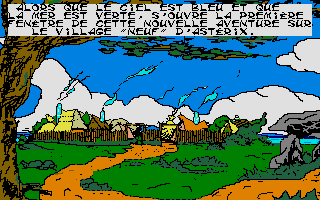
Astérix chez Rahàzade (Atari ST)
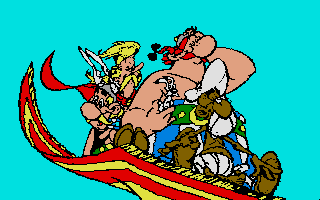
Astérix chez Rahàzade (Atari ST)
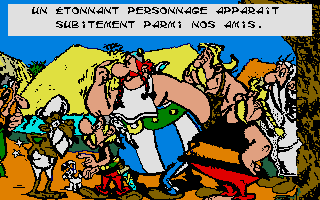
Astérix chez Rahàzade (Atari ST)
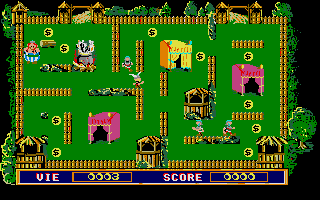
Astérix chez Rahàzade (Atari ST)
Screen Comparison
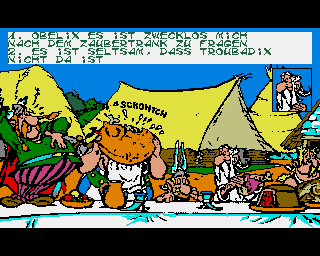
Amiga
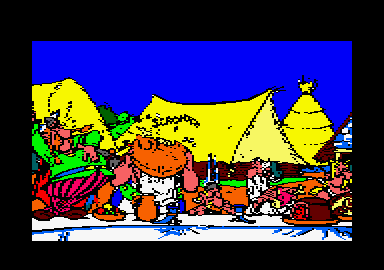
Amstrad CPC
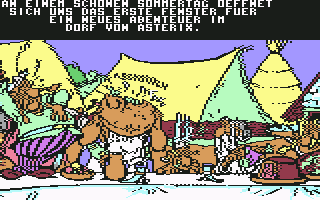
Commodore 64
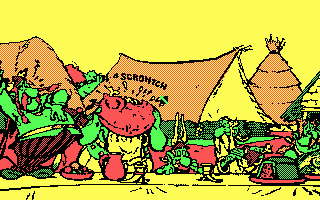
IBM PC
|
Page 1: |
Page 2: |
Page 3: |
Page 4: |
Page 5: |
|
Page 6: |
Page 7: |
Page 8: |
